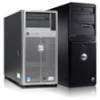Dell PowerEdge R720 Technical Guide - Page 38
Systems with an H310 PERC - weight
 |
View all Dell PowerEdge R720 manuals
Add to My Manuals
Save this manual to your list of manuals |
Page 38 highlights
> The quantity and type of PCIe cards installed: This affects overall system acoustics. Installation of more than two PCIe cards results in an increase in overall system acoustics. > Utilization of a GPU card: This results in an increase in overall system acoustics. > PCIe controller-based SSD drives: Drives such as Express flash drives and Fusion-io® cards require greater airflow for cooling, and result in significantly higher noise levels. > Systems with an H310 PERC: This configuration may be quieter than those with an H710 PERC with battery backup. However, higher noise levels result when a system is configured as non-RAID. > Hot spare feature of power supply unit: In the system default setting, the Hot Spare Feature is disabled; acoustical output from the power supplies is lowest in this setting. Table 21 and Table 22 detail the acoustical performance for the R720 and R720xd. Configuration (23 ± 2°C CPUs ambient) Hard drives Power PCI supply Memory card/HDD unit controller Operating mode LWA-UL1 (bels) LpA2 (dBA) Prominent tones3 Minimum 1 1 x 250GB 1 x SATA (7.2k) 495W 1 x 8GB 1 x PERC H310 Idle Stressed4 4.0 4.1 20 20 None None Typical 1 x PERC Idle 4.4 25 None 2 6 x 300GB 2 x SAS (10K) 750W 8 x 8GB H710, 1 x GbE Stressed4 4.5 26 None NIC Configuration (23 ± 2°C CPUs ambient) Hard drives Power supply unit PCI Memory card/HDD controller Operating mode LWA-UL1 LpA2 (bels) (dBA) Prominent tones3 Minimum 1 1 x 250GB 1 x SATA (7.2k) 495W 1 x 8GB 1 x PERC H310 Idle4 Stressed5 4.7 4.8 28 28 None None Typical 1 x PERC Idle4 4.8 28 None 2 14 x 300GB 2 x SAS (10K) 750W 8 x 8GB H710, 1 x GbE Stressed5 5.0 30 None NIC 1LwA - UL is the upper limit sound power levels (LwA) calculated per section 4.4.1 of ISO 9296 (1988) and measured in accordance to ISO 7779 (2010). 2LpA is the average A-weighted sound pressure level from the four bystander positions calculated per section 4.3 of ISO9296 (1988) and measured in accordance with ISO7779 (2010). The system is placed in a half rack enclosure (base of system is 25 cm above reflective floor). 3Prominent tone: Criteria of D.6 and D.11 of ECMA-74 11th ed. (2010) are followed to determine if discrete tones are prominent. The system is placed in a half rack enclosure (base of system is 75 cm above reflective floor) and acoustic transducer is at front bystander position, ref ISO7779 (2010 Section 8.6.2). 4Idle: Reference ISO7779 (2010) definition 3.1.7; system is running in its OS but no other specific activity. 5Stressed processor: An operating mode per ISO7779 (2010) definition 3.1.6. The software SPECPower at 50% loading is activated to stress the processors. For more information on Dell's acoustical design, see the Dell Enterprise Acoustics white paper. 38 PowerEdge R720 and R720xd Technical Guide















